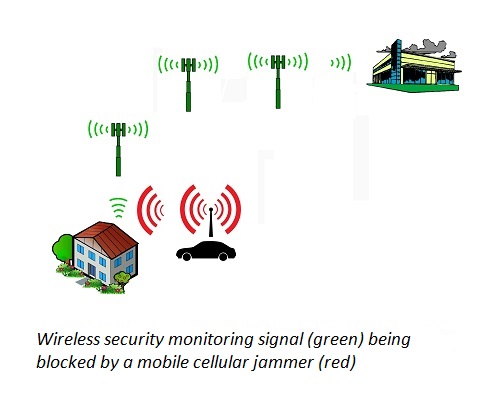- Home
- Compare Systems
- Cheap Systems
- Free Quotes
- DIY Systems
- Hardwired Systems
- Wireless Systems
- Smoke Detectors
- Medical Alarms
- Alarm Monitoring
- Cameras & Video
- Ademco
- ADT Security
- Brinks Security
- Broadview
- DSC Security
- FBI Alarms
- GE Security
- Honeywell
- Link Interactive
- Monitronics
- Moose
- Napco
- Protection 1
- Radionics
- Simplisafe
- Alarm Manuals
- Alarm System Parts
- Alarm Tools
- Troubleshooting
- FAQ
- Glossary
- Sitemap
- About Me
- Contact Me
Wireless Security Monitoring Versus a Cellular Jammer
Wireless security monitoring capabilities are being built into more and more home alarm systems every day. This is largely driven by the fact that more and more people are relying on their cellphones, and are ditching their landline-based home telephone service. Many DIY alarm systems now use cellular reporting, and it’s also a very good choice for an apartment security system.
Wireless alarm monitoring uses a cellular network to send alarm signals
to a central monitoring station, rather than using traditional copper
phone lines. This not only eliminates the need for a land line phone; it
avoids the threat that alarm signals could be prevented by simply
cutting the phone line.
However, wireless home security
monitoring comes with its own concern; namely, that a cellular jammer could be used to disrupt the transmission of
alarm signals, preventing a police response to a break-in.
In
this article, I’ll discuss what I see as the possible versus the
realistic threats your cellular alarm monitoring system may face.
Learn the basics of wireless alarm monitoring.
What Would an “Average” Burglar Do?
While there is no such thing as an "average" or "typical" burglar, here is what crime statistics tell us:
- Most burglars are unsophisticated, and are looking for quick cash from easily sold items like jewelry, guns, small electronics, laptops, etc.
- Most thieves use simple, inexpensive tools to break in, including screwdrivers, pry bars, pliers, and hammers.
- Some will cut phone lines to defeat the alarm system, though most prefer to target homes without security systems.
- Most burglars spend very little time inside the home, making capture by police fairly unlikely.
But what about a sophisticated thief? What could a determined burglar do?
Cellular Jammer Technology
Imagine yourself trying to have a conversation with a friend while standing next to a loudspeaker at a heavy metal concert.
You and your friend probably wouldn't be able to hear each other, since the loudspeaker would simply drown out your voices.
Cellular jammers work in a similar way by transmitting signals at the same frequency as the device being jammed, overwhelming the intended signals with meaningless noise.

Some
jamming devices can transmit at multiple frequencies, preventing several
different bands of communication at once. Others can sweep repeatedly
over a bandwidth, or range of frequencies to make absolutely sure they
are blocking the specific frequency being targeted.

A quick
internet search shows lots of jamming equipment for sale, promising to
be effective at stopping signals from cell phones and other cellular
devices. Jammers are available for all bandwidths in which cellular
communications occur, so no cellular frequencies or networks can be
considered safe from disruption.
Can Wireless Security Monitoring Be Jammed?
Controlled tests have demonstrated that it is possible to use radio jammers to defeat various alarm system communications.
Successful jamming requires:
- Knowledge of the frequency you are trying to jam
- Adequate signal strength
- Close proximity to the target
With these three key factors, there is no question that wireless security monitoring signals can be blocked.
In
the controlled tests mentioned above, those performing the jamming had
direct access to the alarm device to be jammed, and knew exactly which
frequencies to transmit on.
I have been unable to find any
documented cases of a wireless alarm jammer being used in actual burglaries to
prevent wireless alarm monitoring signals. As of 2014, FBI crime statistics that
classify how burglaries occur don’t even list cellular jamming as an
attack method used during a break-in. This tells me that, at least for
now, the use of jammers against wireless security monitoring is not a
common occurrence.
That said, let’s suppose, hypothetically, that a would-be burglar did want to jam your wireless security monitoring system.
What difficulties would he face?
Just how likely is this to happen?
Risk of Possession
To start with, cellular jamming is illegal in many countries,
including the United States. A thief driving around in possession of a mobile
jammer in search of a target home would face some difficult questions if
stopped by police. If caught actually using a wireless/cellular jammer, he could
face seizure of the equipment, substantial fines, and possible
imprisonment.
Granted, a thief caught committing a burglary is already facing fines and imprisonment anyway, so this fact alone probably wouldn’t be a key factor in deciding whether or not to use a cellular jammer.
Cost of Equipment
Cellular jamming equipment is not cheap, at least for anything that
might actually be effective against wireless security monitoring signals. Prices
I’ve seen in online searches for wireless alarm jammers vary between a few hundred to several thousand dollars.
Wireless security monitoring can only be disrupted if a cellular jammer has sufficient power and is physically close enough to the home. Most jamming equipment ads list effective ranges of from tens of feet to tens of meters.
Higher-end
units are necessary for transmitting at extended ranges, and for the
ability to jam signals on multiple frequencies. A burglar attempting to
jam alarm monitoring would likely choose the most powerful equipment he
could afford, in order to have the best chance for success.
Anti-jamming or Jam Detection Technology

Several wireless home security alarm manufacturers, including Simplisafe and GE, have anti-jamming features built into their cellular-equipped security panels. These systems actively detect radio signals in their own cellular band, and will then alert the alarm owner of a possible jamming attempt.
For home wireless security systems that are also
set up to report over a data or telephone line, a signal can be sent to
the monitoring station as soon as a cellular jamming signal is
detected.
Wireless Jamming Reliability (Verifiability)
Suppose a burglar, intent on pillaging the vast riches he is sure lay hidden in that expensive-looking home in the nice area of town.
He transports his high-tech cellular jamming equipment to the intended
target house and parks nearby. When all is ready, he flips the switch,
powering up his top-of-the-line cellular jammer.
Being smarter
than your average burglar, he realizes that his wireless jamming device
will have no effect on a wired telephone or internet connection.
He might also understand that anti-jamming features may already be
sending an alert over those same wired connections, so he must approach
the house and cut any data or phone wires leading from the house to the
outside world.
At this point the land lines are cut, and pose no threat.
Theoretically,
his jamming device has blocked all wireless communications into
or out of the house, preventing any alarm signals from being
transmitted.
But, how can he be sure?
The truth is, he can’t. Not absolutely.
He
would have to consider that the panel’s jamming detection feature has
alerted the homeowner to his actions, even before any entry is made into
the house.
And, when he actually does break in and the alarm system is tripped, he would have to assume that SOME signal MAY get through.
So really, how effective can his cellular jammer be?
NO
burglar wants to get caught, and getting in and out quickly is the best
way to avoid this. At the end of the day, jamming an alarm system
doesn’t provide much of an advantage over a simple “smash-and-grab”
approach.
The scenario above shows what I see as the biggest weakness of trying to jam wireless security monitoring signals: there is no way to verify that it’s working.
Aside from any of these concerns, add in the
fact that all alarm systems will still function locally, with an
audible alarm, even if they can’t communicate to the outside world. So,
from the moment of a break-in, the alarm system will be sounding an
audible siren inside the home, and may also have an exterior siren to
alert the neighbors.
Is Wireless Security Monitoring Safe from Cellular Jamming?
So, in most cases, the “average” thief will most likely be a fairly
unsophisticated smash-and-grab burglar, who might cut phone lines, but
won’t likely go to the expense and effort of buying and using a cellular
jammer. He is most likely not a threat to disable your wireless security monitoring.
How
about the more sophisticated burglar? Even a careful cellular jammer
user can’t be sure if his device is 100% effective. He would have to
realize the risk of incomplete jamming, and would likely have to behave
as if the police are on their way. And, he would certainly prefer
hitting the house next door, with no alarm system at all.
Conclusions
Like all security measures, no burglar alarm monitoring method is totally secure.
Just
as installing good locks, outside lighting, and even security bars
cannot prevent all burglaries, they are still the best steps to deter
the majority of attempts and reduce the chances of a break-in.
Likewise,
wireless security monitoring will make defeating your alarm system
communication more difficult for a would-be burglar.
Learn more about Wireless Alarm Monitoring.
If you haven't done so already, get a few Free Home Security Systems Quotes from companies in your area.
This will give you a good idea of what it would cost to have a system installed, as well as how much you could save by doing it yourself.
Related Articles
Should I Self-Monitor My Alarm System?
Return to Home Alarm System Monitoring from Wireless Security Monitoring
Return to Home Security Systems Answers from Wireless Security Monitoring
Note: Feel free to print any of the articles on this site for personal, non-commercial use. Just look for this button:
If you found this website especially helpful, you might want to consider making a small donation. Since 2011, AzAlarmGuy has been providing free help and advice on home security systems to all of those in need.
Your gift, in any amount, will help me keep this website a free resource for anyone needing help with alarm system issues or questions.
Disclosure
I receive affiliate commissions from some of the companies and products I discuss. These commissions don't change the price that you pay.
Rest assured that this compensation does not influence my recommendations. I only endorse products and services that I truly believe to be an honest value for you, as a visitor to my site.
For more details, see my full disclaimer.





